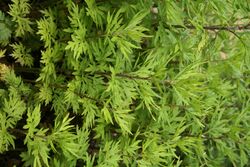Biology:Artemisia verlotiorum
| Artemisia verlotiorum | |
|---|---|

| |
| Scientific classification | |
| Kingdom: | Plantae |
| Clade: | Tracheophytes |
| Clade: | Angiosperms |
| Clade: | Eudicots |
| Clade: | Asterids |
| Order: | Asterales |
| Family: | Asteraceae |
| Genus: | Artemisia |
| Species: | A. verlotiorum
|
| Binomial name | |
| Artemisia verlotiorum Lamotte
| |
| Synonyms[2] | |
Artemisia verlotiorum, the Chinese mugwort, is a species of plant in the sunflower family, widespread across much of Eurasia.[3][4]
Etymology
It is named for Jean Baptiste Verlot, who first distinguished the plant from Artemisia vulgaris in 1877 and for his brother Pierre Bernard Verlot, and is sometimes referred to as Verlot's Mugwort.[5]
Description
It has oblong reddish to brown capitula, its stems are green and the leaves broader, lighter colored and denser on the stem. The plant is more strongly and pleasantly aromatic than Artemisia vulgaris.[6] It flowers very late in the summer, but reproduces mainly by stolons, thus forming thick groups. Chinese Mugwort shares the same habitat as Artemisia vulgaris, and both are very common.
Artemisia verlotiorum is often confused with Artemisia vulgaris ("common mugwort"), which is closely related.[7]
| Differences between | Artemisia verlotiorum | Artemisia vulgaris |
| Growth form | rhizomes present, plant strongly stoloniferous | rhizomes absent or present, plant not stoloniferous |
| Leaves | lighter green | dark green |
| Lobes of adult leaves | lanceolate and entire | ovate-lanceolate and toothed |
| Synflorescence | green, nodding | brownish, erect |
| Connective above anther | acuminate | acute |
| Scent | aromatic | not aromatic |
| Flowering period | September–November | July–September |
| Chromosome number | 2n = 48 | 2n = 16 |
References
- ↑ Tropicos, Artemisia verlotiorum Lamotte
- ↑ The Plant List Artemisia verlotiorum Lamotte
- ↑ Flora of China, 南艾蒿 nan ai hao Artemisia verlotorum Lamotte, Mém. Assoc. Franç. Congr. Clermont Ferrand. 1876: 511. 1876.
- ↑ Altervista Flora Italiana, Assenzio dei fratelli Verlot, Artemisia verlotiorum Lamotte
- ↑ Haider, F.; A.A. Naqvi; G.D. Bagchi (Sep–Oct 2006). "Chemical Constituents of Artemisia verlotiorum Essential Oil on Cultivation at the Subtropical Conditions of North India". Journal of Essential Oil Research 18 (5): 551–552. doi:10.1080/10412905.2006.9699164. https://dx.doi.org/10.1080/10412905.2006.9699164. Retrieved 2008-01-18.
- ↑ "Artemisia". IENICA Database. IENICA. http://www.ienica.net/crops/artemisia.htm.
- ↑ Eleonora Gabrielian & Joan Vallès Xirau: New Data about the Genus Artemisia L. (Asteraceae) in Armenia. Willdenowia Bd. 26, H. 1/2 (Nov. 29, 1996), pp. 245-250.
Wikidata ☰ Q3915744 entry
 |

